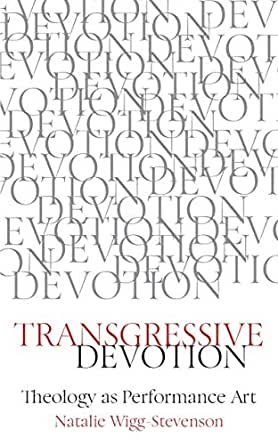I remember one of my university teachers sitting in on a seminar that I was leading some 20 years ago. He was attentive and appeared to be making careful notes. On the feedback form his only comment was, ‘clearly expressed and excellent engagement with the group, but I wanted to hear and learn something arresting and original’. While it was not easy to hear, I parked the comment and moved on from the discomfort of the challenge.
Reading this book took me back into the core what it is that shapes our practice and thought in both ministry and theology. As a regular reviewer, I am often impressed by the skill of a writer that is demonstrated in the processing of her thinking into well organised arguments and chapters. However, some of this is often unimaginative, a little dull but often unprepared to move the ‘boat of theology’ out of the safe harbours of Church and Academy.
This brilliant book is a tour de force – a work of art that is both breath-taking, disruptive, and extraordinarily honest about some of the theological questions that shape our learning life. SCM are to be congratulated on consistently taking a risk on new writers and being faithful to its tradition of publishing radical, thought bending theology.
Wigg-Stevenson invites her reader into a journey of adventure. She digs deep into the tradition but also gives voice to the complexities of our human experience. Why? We need to see and construct reality differently. Her careful use of words and method as a performance theologian takes this reader into a dimension of reflexivity which is enlarging and uncomfortable. It is never very far away from resonating with experience. It is at the same time both personal and public. It is written out of the personal experience of finding a way back into the divine reality following alienation and marginalisation in both Academy and Church.
Transgressive Devotion builds all kinds of bridges. The writing is shaped by progressive theology that is informed by a queer and feminist perspective. It is also influenced by evangelical, charismatic Christianity. The book takes seriously salvation, the cross, Scripture and worship. The chapters that follow are also a robust attack on forms of Christianity which are dangerous in their romanticisation and idolisation of human weakness and vulnerability.
This makes the book difficult to categorise. It is relentless in its transgression and its questioning. It presents several important historical writers and celebrates what it might mean to experiment with their genre. Much to this reader’s surprise and satisfaction. My copy of this book is littered with notes and pencil marks indicating connection and resonance at the turning of every page. Arresting and original characterise this text as it moves and swerves through the carefully organised schema.
Seven chapters frame the writing: Father, Spirit, Son, Church, Salvation, Humanity and Closing. The test in shaped and deepened through several beautifully crafted descriptions of performance art. Alongside deep dives into the Christian tradition ( look carefully at the skill of the footnotes and references that take the reader on a journey this research) and these all form part of the process of theological reflexivity.
In Chapter One we are invited into a description of two men ‘shooting up’ set against the context of the Vietnam war. It is shocking, but the aim of this description is to invite us into thinking about what it means to call God Father. This image is reimagined in an Alzheimer’s patient who cannot remember who they are. Does God recognise us? Can we bear to know God as vulnerable, broken and frail? It becomes necessary for us to question and interrogate the omnipotence, impassibility and omniscience of God.
This is embodied theology that takes human life, the complexity and richness of our sexuality and fantasies seriously. Who are we? What do we long to be? From what are we running away from? What will help us to face the sheer mess of life looking at us back in our mirrors? The text narrates the way in which both church and society have sought to police and control bodies, sexual practices, and identity. As other writers have explored in our responses to HIV/AIDs there is a rich and life-giving relationship between eros and spirituality. The text is suggestive and moves away from any systematic process of argument or discussion.
Absent are bland and comforting answers. Images are offered for the reader to sit with and reflect upon. Some might find the language and images in this performance art, especially those around sex and violence, both provoking and alienating. The reader is shown how sex and violence are part of our condition and we need to think how best to deal with these sensitivities and vulnerabilities. 
Wigg -Stevenson grounds much of this narrative in sensitivity to the range of beliefs that are embodied in our attitudes and practices. The Christology here is of a Christ who moves back and forth through time and disrupts history. It follows that we can hold the real and the ideal when we view and talk about Christ. While both are disfigured by both projection and fantasy this is our life. We can find God and salvation for our oppressions and limitations. This requires a whole different set of restructuring our memories and narrating our stories. Autoethnography involves our writing theology that is real, fragile, hurting and, often, deeply unresolved. This is, as the author argues, part of what it means to be Church. We are all bound up in a not- yet -redeemed brokenness. In this brokenness, we may discover where God’s glory is hiding. Wigg Stevenson goes on to invite us into a kenosis and erotic theosis that are the ground of reconciliation. In this process we nurture a different relationship with our memories and new revelations become possible.
Few practical theologians have offered satisfactory narratives for the theologicaldifficulties posed by dementia for both our understanding of the providence of God and our belief that human beings are made in the image of that loving God. In the latter part of the book, Wigg Stevenson uses the concept of attunement to help us understand agency as non-competitive. In other words, we might think about grieving for the attributes of God that no longer manifest themselves in this suffering and by doing so, we invite the possibility of new divine attributes to come forth. In this framework, worship, liturgy and prayer are reimagined as practices that can re-orientate us to a different relationship with one another and creation. In this process we need both fantasy and reality!
This is not an easy or comfortable read but herein lies the books generativity. Read it slowly. Read it with a trusted colleague, friend, or study group. It may be that this age needs some honest deconstruction and disorientation to know what we can trust and where wisdom can be found. Theology that should be ‘re-centered’ is, for Wigg-Stevenson, at the heart of our journey. How the Cross and the Incarnation are re-centred, transgressed and described lie at the heart of the questions that are asked of progressive theologians.
No refuge is taken in easy solutions. At every turn of the page her reader is taken deeper into a creative self-honesty. It is moving and challenging in equal measure. It is real, poetic, suggestive, demanding, heartful and imaginative. It offers a different mode of theology.

